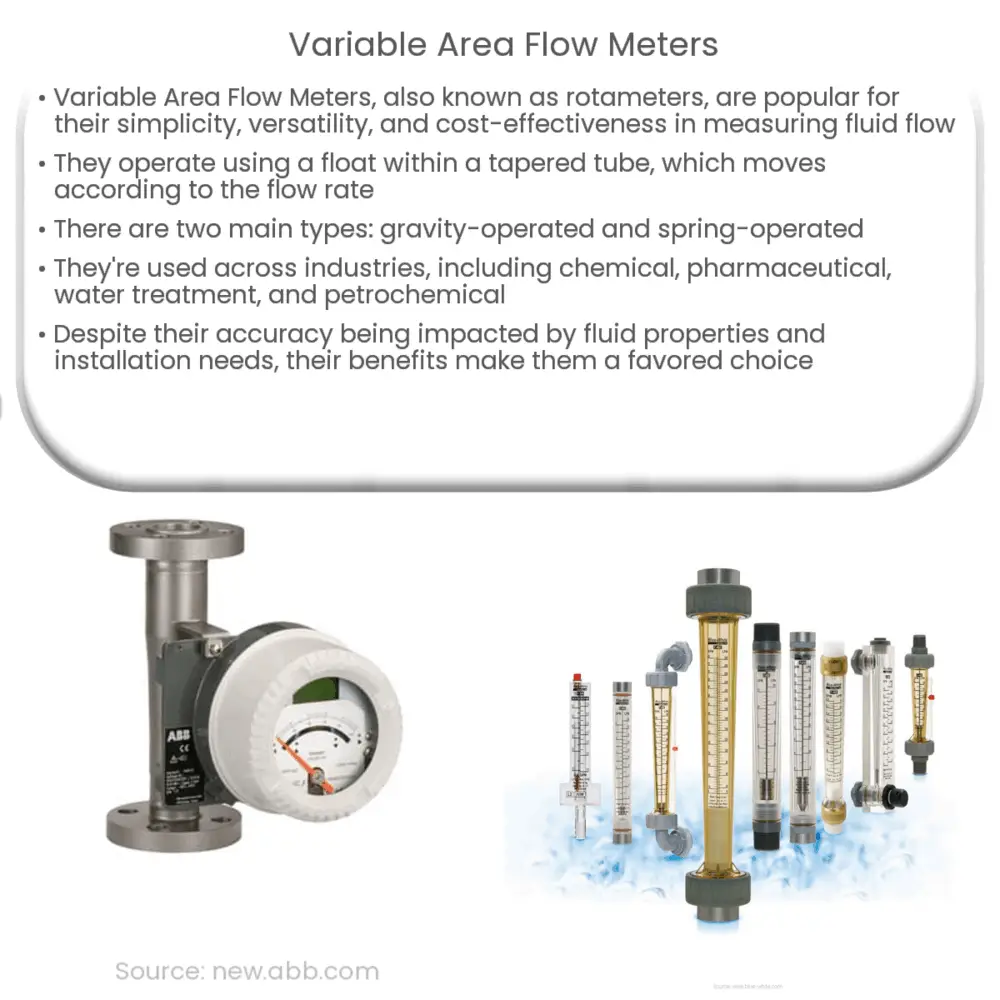Explore the principles, components, types, applications, advantages, and drawbacks of Variable Area Flow Meters in our detailed guide.

Introduction to Variable Area Flow Meters
Flow measurement is a critical aspect of many industrial processes. One of the most popular and versatile devices used for this purpose is the Variable Area Flow Meter, also known as a rotameter. This device offers the advantages of simplicity, versatility, and cost-effectiveness, making it a favorite in many industries.
Principle of Operation
A Variable Area Flow Meter operates on a simple but effective principle. The device consists of a tapered tube, typically made of glass or plastic, within which a ‘float’ or a ‘bob’ moves freely. The position of the float correlates to the flow rate of the fluid passing through the meter. As the fluid flow increases, the float rises in the tube. Conversely, when the flow decreases, the float descends. The float’s position, therefore, indicates the fluid’s velocity or volumetric flow rate.
Components of a Variable Area Flow Meter
Tapered Tube: This is the primary component where fluid flows. The tube is wider at the top and narrower at the bottom, enabling the float to move up and down depending on the flow rate.
Float: This is the moving part within the tapered tube. The float rises with increasing flow and falls with decreasing flow. It can be made of various materials depending on the nature of the fluid being measured.
Scale: This is the reading device on the meter. It is calibrated to show the flow rate based on the float’s position in the tube.
Types of Variable Area Flow Meters
There are two main types of variable area flow meters:
-
Gravity Operated: Also known as a rotameter, this type relies on the balance between the gravitational force and the upward force of the fluid flow to position the float.
-
Spring Operated: These have a spring mechanism to counterbalance the upward force of the fluid. They can be installed in any orientation and are preferred for use in situations where vertical installation is not possible.
Both types can be further differentiated based on factors like the type of measurement (liquid or gas), required accuracy, installation orientation, and the material of construction.
Applications of Variable Area Flow Meters
Variable Area Flow Meters are used in various industries and applications due to their flexibility and adaptability. Some of the most common applications include:
Chemical Industry: For metering aggressive and corrosive substances, Variable Area Flow Meters made of resistant materials like borosilicate glass or PTFE are used.
Pharmaceutical Industry: They are used for measuring the flow of pharmaceutical fluids in a sanitary and controlled environment. These meters are often made of stainless steel to ensure cleanliness and sterility.
Water Treatment: These meters are commonly used to monitor the flow of water and other fluids in water treatment facilities.
Petrochemical and Gas: Variable Area Flow Meters are used for the accurate measurement of oil, gas, and other hydrocarbons in the petrochemical industry.
Advantages and Disadvantages
Like any other technology, Variable Area Flow Meters have both advantages and disadvantages:
Advantages: They are simple in design, versatile, and cost-effective. They require no external power source and provide a direct visual indication of the flow rate. They can handle a wide range of flow rates and are available in various materials to suit different application needs.
Disadvantages: The accuracy of these meters can be affected by the fluid’s viscosity and density. They are typically less accurate than other types of flow meters. They also need to be installed vertically (except spring-operated types) and require a straight run of pipe for accurate operation.
Conclusion
In conclusion, Variable Area Flow Meters are simple yet effective tools for measuring fluid flow in a wide array of applications. While they have some limitations, their benefits of versatility, simplicity, and cost-effectiveness make them a popular choice across many industries. Whether it’s in the pharmaceutical industry ensuring precise measurements of critical fluids or in water treatment facilities monitoring the flow of water, these devices play a crucial role in maintaining and enhancing the efficiency and effectiveness of many processes.

